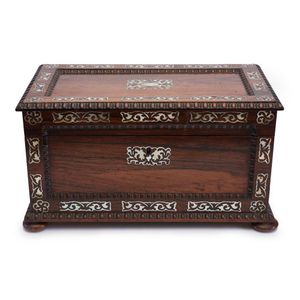Victorian Anglo-Indian Mother-of-Pearl Tea Caddy
You must be a subscriber, and be logged in to view price and dealer details.
Subscribe Now to view actual auction price for this item
When you subscribe, you have the option of setting the currency in which to display prices to $Au, $US, $NZ or Stg.
- Victorian Period - The Victorian period of furniture and decorative arts design covers the reign of Queen Victoria from 1837 to 1901. There was not one dominant style of furniture in the Victorian period. Designers used and modified many historical styles such as Gothic, Tudor, Elizabethan, English Rococo, Neoclassical and others, although use of some styles, such as English Rococo and Gothic tended to dominate the furniture manufacture of the period.
The Victorian period was preceded by the Regency and William IV periods, and followed by the Edwardian period, named for Edward VII (1841 ? 1910) who was King of the United Kingdom and the British Dominions and Emperor of India for the brief period from 1901 until his death in 1910. - Mother-Of-Pearl - Mother-of-pearl, technical name "nacre", is the inner layer of a sea shell. The iridescent colours and strength of this material were widely used in the nineteenth century as an inlay in jewellery, furniture, (especially papier mache furniture) and musical instruments.
In the early 1900s it was used to make pearl buttons. Mother-of-pearl is a soft material that is easily cut or engraved.
Nowadays it is a by-product of the oyster, freshwater pearl mussel and abalone industries.
This item has been included into following indexes:
- Anglo-Indian Vizagapatam and sadeli boxes - sewing and other boxes 324
-
tea caddies, material
- mother of pearl 14
- other materials 140
- tea caddies, period or age - Victorian 189
Visually similar items

A World War II button compass, brass body missing top, plus other buttons, used in World War II for secret service missions

A pair of famille rose bowls one with wooden stand Read seal mark to base, height 7 cm, length 22 cm

A set of four sterling silver American tea or dessert spoons, 1936, pattern introduced, with maker's mark of Gorham, the 'King Edward' pattern spoons with foliate scrolls and terminals; marked to stems underside, silver weight 120gr length 15 cm

A small vintage green mint painted stool, circa 1920, 61 cm high, 34 cm square
